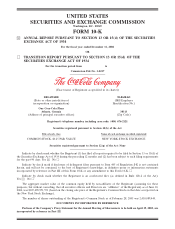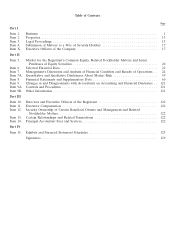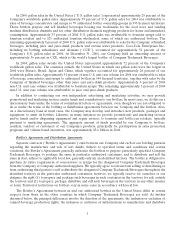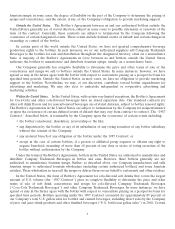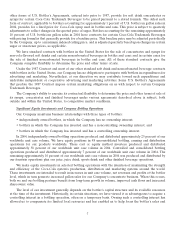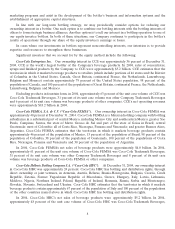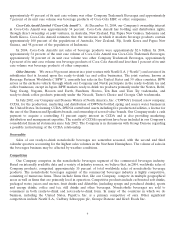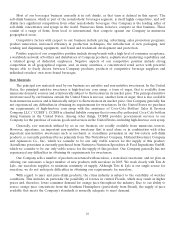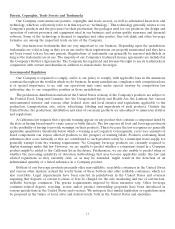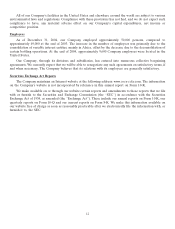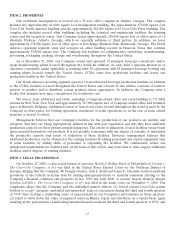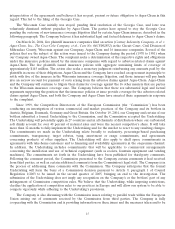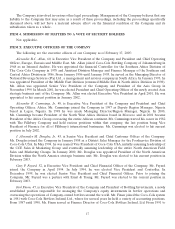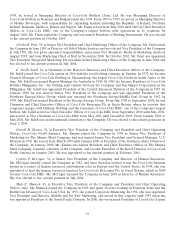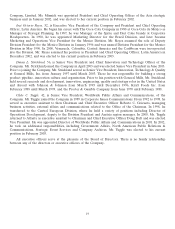Coca Cola 2004 Annual Report Download - page 11
Download and view the complete annual report
Please find page 11 of the 2004 Coca Cola annual report below. You can navigate through the pages in the report by either clicking on the pages listed below, or by using the keyword search tool below to find specific information within the annual report.
approximately 45 percent of its unit case volume was other Company Trademark Beverages and approximately
7 percent of its unit case volume was beverage products of Coca-Cola HBC or other companies.
Coca-Cola Amatil Limited (‘‘Coca-Cola Amatil’’). At December 31, 2004, our Company’s ownership interest
in Coca-Cola Amatil was approximately 34 percent. Coca-Cola Amatil has bottling and distribution rights,
through direct ownership or joint ventures, in Australia, New Zealand, Fiji, Papua New Guinea, Indonesia and
South Korea. Coca-Cola Amatil estimates that the territories in which it markets beverage products contain
approximately 100 percent of the populations of Australia, New Zealand, Fiji, South Korea and Papua New
Guinea, and 98 percent of the population of Indonesia.
In 2004, Coca-Cola Amatil’s net sales of beverage products were approximately $2.6 billion. In 2004,
approximately 54 percent of the unit case volume of Coca-Cola Amatil was Coca-Cola Trademark Beverages,
approximately 38 percent of its unit case volume was other Company Trademark Beverages, approximately
8 percent of its unit case volume was beverage products of Coca-Cola Amatil and less than 1 percent of its unit
case volume was beverage products of other companies.
Other Interests. We own a 50 percent interest in a joint venture with Nestl´
e S.A. (‘‘Nestl´
e’’) and certain of its
subsidiaries that is focused upon the ready-to-drink tea and coffee businesses. The joint venture, known as
Beverage Partners Worldwide (‘‘BPW’’), currently has sales in the United States and 59 other countries. BPW
serves as the exclusive vehicle through which our Company and Nestl´
e participate in the ready-to-drink tea and
coffee businesses, except in Japan. BPW markets ready-to-drink tea products primarily under the Nestea, Belt´
e,
Yang Guang, Nagomi, Heaven and Earth, Funchum, Frestea, Ten Ren and Tian Tey trademarks, and
ready-to-drink coffee products primarily under the Nescaf´
e, Taster’s Choice and Georgia Club trademarks.
In July 2002, our Company and Danone Waters of North America, Inc. (‘‘DWNA’’) formed a new company,
CCDA, for the production, marketing and distribution of DWNA’s bottled spring and source water business in
the United States. In forming CCDA, DWNA contributed assets including five production facilities, a license for
the use of the Dannon and Sparkletts brands, and ownership of several value brands. Our Company made a cash
payment to acquire a controlling 51 percent equity interest in CCDA and is also providing marketing,
distribution and management expertise. The results of CCDA’s operations have been included in our Company’s
consolidated financial statements since July 2002. The Company is in discussions with Group Danone regarding
a possible restructuring of the CCDA relationship.
Seasonality
Sales of our ready-to-drink nonalcoholic beverages are somewhat seasonal, with the second and third
calendar quarters accounting for the highest sales volumes in the Northern Hemisphere. The volume of sales in
the beverages business may be affected by weather conditions.
Competition
Our Company competes in the nonalcoholic beverages segment of the commercial beverages industry.
Based on internally available data and a variety of industry sources, we believe that, in 2004, worldwide sales of
Company products, comprised approximately 10 percent of total worldwide sales of nonalcoholic beverage
products. The nonalcoholic beverages segment of the commercial beverages industry is highly competitive,
consisting of numerous firms. These include firms that, like our Company, compete in multiple geographical
areas as well as firms that are primarily local in operation. Competitive products include carbonated soft drinks,
packaged water, juices and nectars, fruit drinks and dilutables (including syrups and powdered drinks), sports
and energy drinks, coffee and tea, still drinks and other beverages. Nonalcoholic beverages are sold to
consumers in both ready-to-drink and not-ready-to-drink form. In many of the countries in which we do
business, including the United States, PepsiCo, Inc. is a primary competitor of ours. Other significant
competitors include Nestl´
e S.A., Cadbury Schweppes plc, Groupe Danone and Kraft Foods Inc.
9

